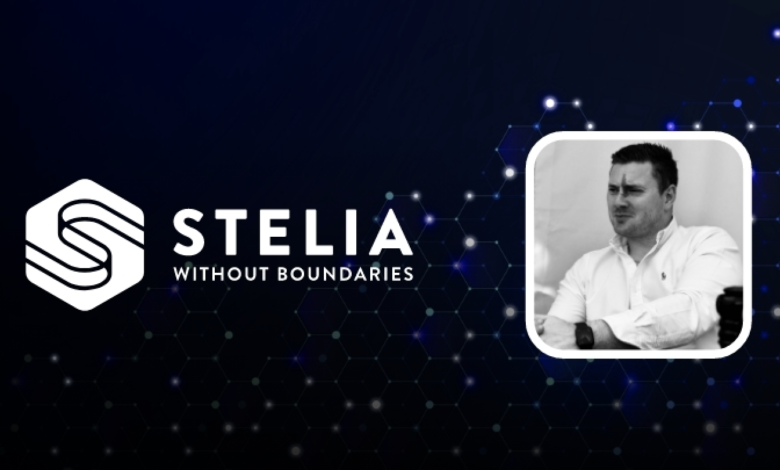
Tobias Hooton had worked overseas for years on top-secret missions—and had barely survived. But the real miracle came when he reached out to his future wife.
“I came back from overseas, and I didn’t know anyone anymore, and I remembered this girl I used to sit next to in primary school,” he said in an interview.
He found her on Facebook and asked if she remembered him.
“Of course, I do,” she wrote back. “We sat next to each other for years.”
In the end, there were no obstacles between their mutual memories of each other.
A new way of defining data
That is the way Hooton approaches his work now—except rather than memories, he works with data.
In the Wild Wild West of the new AI economy, as investors are throwing trillions and trillions of dollars into ventures of all kinds, Hooton is removing all obstacles to the way data is transferred—with huge implications for AI.
The company he founded, Stelia, doesn’t even talk about data in the same way.
The long and winding road: the traditional internet
He started Stelia, after selecting a group of former coworkers and others with a similar agenda, to look at the industry’s future over the next 40-50 years after realizing the current way of transferring data would not be up to the challenge.
“The internet as we know it is held together with pieces of string and sticky tape,” he said.
The current way of transferring data is akin to having a Zoom call with someone but relying on multiple intermediaries to pass on and forward the image and sound.
The analogy he gave involved you speaking in sign language to one person over Zoom, then that person speaking German to another person over Skype who then uses Google Translate to turn it into English, then that person speaking in English over Microsoft Teams to someone who writes it down in short hand then hands it to someone else who then runs across the room and gives it to someone who can read shorthand who then translates it back into English, which is then read by someone who knows sign language. That person now gets onto Zoom and communicates with you.
“Our traffic now is going by a subset of intermediaries and then there’s apps as well,” he said. “So in the normal connected world if your email arrives ten seconds late no one cares, and you can get away with that.”
But it’s not going to work with what’s coming, he said.
First coding using Excel!
Hooton was first inspired when he was about 9 or 10, when his father, who also worked in the Middle East, brought home an early Olivetti laptop.
Hooton began making a few dollars (pounds) on the “rent-a-coder” website, through which people could hire someone to fix a bug in their computer or connect devices.
His first project involved programming a printer to reveal its intended image on the screen before printing—something we take for granted today.
Not knowing how to write code in a traditional way, he used an accounting spreadsheet to write a formula that would combine the code needed to drive the printer’s operation.
“Hence, my first ever actual code was written using Excel, which knowing what I do now, was very naive of me!”
Transitions
Using his coding skills he had continued to develop, he eventually worked all over the globe, in British aerospace and defense, special forces, as a defense contractor, and leading his own companies, such as one that hosted cloud computing.
His transition to the CEO of Stelia, which he started with his own investment, came after he sold his business into the group of 01 Telecom Ltd.
“They killed all innovation, sacked my entire company, and the leadership team was asleep at the wheel,” he said.
01 Telecom was then sold to another company, he said.
Hooton’s comments about some of the big telecom companies are unflattering, but they do not veer too far from objective industry analysis.
He describes them as deeply in debt, losing business, and sometimes simply selling the same thing with a slightly different wrapper.
“Their value is based on their fiber, but all that’s happened in the last 30 years is their finding new ways of selling that fiber with slightly new wavelengths, although they call it something else,” he said.
AT&T had a debt of about $140 billion in June. Its management remains “focused on debt reduction,” according to Morningstar.
An opportunity for telecoms?
On the other hand, he describes the telecoms as failing into two camps, one being more traditional, that have “commercialized using very old technology that’s been around for at least 30 years.”
Said Hooton, “They’re doing what they can with their equipment from the likes of Adva, Ciena, Nokia, etc. But they’re bound by the limitations of these legacy brands and features.”
The other camp involves those looking for entirely new ways to transmit data.
They look at Stelia and say, “You’re the answer to our prayers,” said Hooton. “They say, ‘We can now enter an entirely new market we know nothing about—we now have an offering that is first in AI and we can deploy it on the fiber we already own.’”
Movies on order—in seconds
As he details what’s coming down the pike in AI—and what his company is already enabling, the wonder throbs in his voice.
One company that relies on Stelia produces immersive gaming experiences, with neural stimulators on the wrists fingers, and forehead.
Another creates movies to order—in real-time.
Moreover, 10 people can watch the same movie from different continents and from different perspectives.
“We’re so early in humanity’s journey with artificial intelligence that we need to build a whole new underlying infrastructure to stitch resources together on a global level,” he said.
In the case of the movie company, for instance, he said by way of example to imagine if DreamWorks were making a movie in California, but their server was in Canada, and the viewers of the movie were around the world.
“Without companies like us, certain parts of the market would not exist,” he said.
The protocols that send information around the internet are so convoluted and slow, except in the cases of hyper scalers like Google and Microsoft, who have built their own protocols, that it simply can’t relay data at fast enough speeds for such AI ventures.
Escaping the hierarchy for super-fast speeds
Companies like Stelia facilitate edge computing, meaning data can travel instantaneously between devices or nearby servers—rather than having to travel in some cases halfway around the globe to data centers and back.
Another thing they do is reduce the size of the chunks needed on a fiber optic cable to transmit data.
Stelia is using the shortest possible spacing for wavelengths on fiber optic cables.
“One of our areas of innovation in our underlying platform is in Optics, where we achieve utilisation within the 50Ghz band over 800Gbps per wavelength,” said Hooton. “In the open market, most are using 112Ghz if not more to achieve 100Gbps speeds. In other words, we deliver over 1600Gbps of capacity where anybody else using a major named brand can only deliver 100. We think we can double this as well in the next 12 months.”
As a result of such changes, Hooton said, the conversation has shifted.
“We don’t talk about speeds or capacity or bandwidth—rather there are no limits on capacity,” he said.
Earlier attempts to transmit data always involved collecting data from lower down on a pyramid and squeezing it upwards into a single “pipe” and out.
The pipe could be made larger. But the process was unchanged.
Additionally, traditional telecoms sell the same “space” on a pipe to multiple customers, hoping they won’t all use it at the same time. But when they invariably do, there are traffic jams, and slowdowns.
In technical terms, this refers to “contention”—it creates a competition between different devices or servers on the internet.
“Traditional telco economics rely on contention. That means for every 1G sold, they may sell this 30-40 or even more times. They compress multiple customers into single pipes, and place an industry gamble on those 30-40 people not all wanting their 1G at the same time. This is why you never really get the true speed of connection at home you’re sold by your internet provider, and service is lumpy and inconsistent,” said Hooton.
But when huge floods of data have to pass through the internet for AI computing to take place, such an approach is impossible, he said.
Heterogenous sources of data—devices, the IoT, servers, CPUs, and GPUs—would have to pass through a hierarchy and be routed up into a single stream—the single exit pipe.
“In the new world of high demand, and certainly between these new resource pools, this is not possible. There must always be an overhead surplus of capacity, and no contention. Simply put, if we use contention in this network, nothing works,” said Hooton.
The new approach enables each of the disparate sources to communicate directly with their counterparts, as needed, bypassing the hierarchy.
“GPU’s talk directly try with each other inside the data center, they do this over Nvidia NVLink protocol, or another vendor if you’re an AMD or Intel customer. However between clusters, data centers or providers, this is Stelia,” said Hooton. “We’re the only company focused on this challenge and allowing the next generation of enterprises and industries such as bio-medical sciences and research, to access a globalized super connected pool of resource.”
The fastest companies are moving 100 to 400 gigabits per second, said Hooton.
“We’re moving hundreds of thousands of gigabits per second, or terabits and terabits per second,” he said.
Building from outcome
Broadly speaking, Stelia’s approach is similar to that of the “hyperscalers”—Google, Microsoft, Amazon—who look at what they need first, then design independent systems to accommodate their needs, he said.
“We approach everything as a software company would. So we forget about the underlying hardware for a moment and look at the outcome of what needs to do what. This is how hyperscalers think, they engineer back from outcome, and then look at hardware. In doing so they’re not bound by what is only available today, but free to adapt or develop their own technologies,” said Hooton.
Such an approach allows Stelia to transcend older protocols—ways of transferring data.
“As an example of this, we don’t think about routers and switches, we think about the service of routing, and the service of switching. Once we have this as a service, then we define what it lives on. Right now, this lives on our own platform.”
Uses of super-fast data transfer
And why is this so important?
Not just for games and movies—even ones you describe to a computer—and it then makes them for you in the flash of a second.
Rather, there is a new frontier coming in AI that emerging technologies are only starting to reveal.
“It’s really hard to find the language to articulate the sense and scale of the shift that’s coming,” he said.
Machines are already able to predict what you will do in the next few seconds of your life.
“AI has so many data points on you, it’s like Google on steroids,” he said. “It has 100 million different data points on you per second.” These include everything from the weather, the humidity, what you’ve eaten, where you’ve just been.
He recently had a conversation with a mathematician friend who asked how far back in your life you would have to go to collect enough data points about you to predict your next step.
“We’re actually very pattern based, we work within a set of confines,” he said.
But a machine can do all this in seconds, he said.
Human-machine interaction
Farther down the line is human-machine interaction.
Already, the technology exists to implant a device in the human brain stem that, using AI, can correctly interpret what you are thinking.
And this works even when the person is sedated or unconscious.
Such interfaces are being commercialized by insurance companies that force people to wear Fitbits or glucose monitors if they want coverage.
But they could also be used to unlock some of the oldest mysteries in history.
Soon, researchers may be implanting a device in the brain stem of someone whose body is dead but brain still alive—and reading its thoughts—perhaps even as the person dies.
In such a world, the transmission of data becomes much more than just a matter of commercial import. It becomes spiritual.


